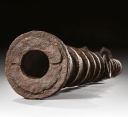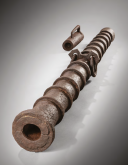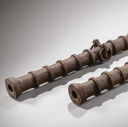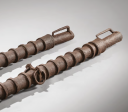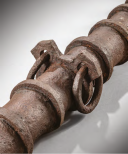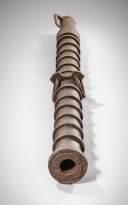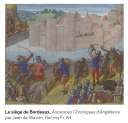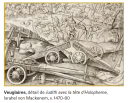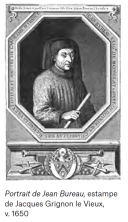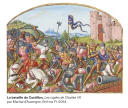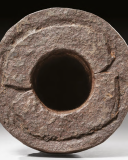
Veuglaires France (found in the Dordogne), mid-15th century. Public auction : TENTATION° 3 Thursday, May 22, 2025 - 6 p.m Drouot - room 9: Giquello et associés
TEMPTATION° 3
Thursday, May 22, 2025 - 6pm
Drouot - Room 9
EXHIBITION
Tuesday, May 20 and Wednesday, May 21, from 11am to 6pm
and Thursday, May 22, from 11am to 4pm
Phone during the exhibition +33(0) 1 48 00 20 09
GIQUELLO
Alexandre Giquello
Violette Stcherbatcheff
5, rue La Boétie - 75008 Paris
+33 (0)1 47 42 78 01 - info@giquello.net
o.v.v. approval no. 2002 389
CONTACT
Arthur Calcet
+33 (0)6 85 91 45 64
a.calcet@giquello.net
SPECIALIST
Marina Viallon
EXPERT
Bertrand Malvaux, CNES
Estimate: 20,000 : 40,000 euros
LOT 5
Veuglaire.
France (found in the Dordogne), mid-15th century.
Iron, wood, gunpowder.
Veuglaire, a medieval breech-loading artillery piece, made of wrought iron, complete with its powder box. The long volley consists of two welded half-tubes, held together by twelve hoops, the sixth from the muzzle augmented by two protrusions to which the two large handling rings are attached. The muzzle facing is enclosed by three hoops of decreasing dimensions, while at the other end, a very wide band reinforces the slot where the powder box fits. The removable powder box, with very thick walls and a roughly forged surface, takes the form of a large cup with an elongated handle, slightly narrower on the side to be inserted into the tube.
It is pierced with a firing port and equipped with a small rim at the breech to secure it to the gun carriage's tightening wedge. Some of the black powder it was filled with when it sank into the Dordogne is preserved inside. Small fragments of the wood of the gun carriage on which the veuglaire rested are preserved in places, trapped in rust. This piece, along with lots 4 and 6 in this current sale, are the only known artillery pieces within the "Castillon group." Total length (with box) 217 cm – Length without box 186 cm
H. (at the rings) 19.5 cm – Length of box alone 39 cm – Caliber 7 cm
Estimate: 15,000/25,000 euros
Provenance:
- Private French collection
- Passed down by inheritance in 1988
Good archaeological condition, stable overall surface oxidation.
LOT 6
Veuglaire
France (found in the Dordogne), mid-15th century.
Iron, wood, gunpowder (probably).
Veuglaire, a medieval breech-loading artillery piece, made of wrought iron, complete with its powder box. The long volley consists of two welded half-tubes, held together by thirteen hoops, the seventh from the muzzle augmented by two protrusions to which the two large handling rings are attached. The muzzle facing is enclosed by three hoops of decreasing dimensions, while at the other end, a very wide band reinforces the location where the powder box fits.
The latter, originally removable, is now stuck due to oxidation. The crudely forged powder box takes the form of a large cup with an elongated handle, slightly narrower on the side to be inserted into the tube. It is pierced with a light for firing and has a small rim at the breech to wedge it with the clamping wedge of the carriage. It is very likely that remnants of black powder are preserved inside. Small fragments of the wood of the carriage on which the veuglaire rested are preserved in places, caught in rust. This piece, along with lots 4 and 5 in this current sale, are the only known artillery pieces within the "Castillon group." Total length (including box) 217 cm – Height (at the rings) 19 cm – Caliber 7 cm
Estimate: 15,000/25,000 euros
Provenance:
- Private French collection,
- Passed down by inheritance in 1988
Very good archaeological condition, stable surface oxidation.
NOTE:
Three unique veuglaires from the Castillon group.
The veuglaire were medium-caliber artillery pieces with relatively long barrels launching small stone cannonballs, preferably used in the field or against the personnel of strongholds. To increase the rate of fire, veuglaires had the characteristic of having a removable powder chamber, called a box, which was fixed to the rear of the tube. Each piece thus had several associated boxes, to be able to chain loadings and increase their rate of fire. Mounted on wheeled carriages, veuglaires, ranging from small to large calibers, are highly mobile pieces and thus became, under Charles VII, the first type of field artillery. The development of a true artillery train within the French army is largely due to the innovations and administrative and technical reforms of the brothers Jean and Gaspard Bureau, about whom the chroniclers of the time heap praise, and who led the royal artillery during the Guyenne campaign of 1453.
At Castillon, on July 17, 1453, according to the chronicles, nearly 300 artillery pieces (all sizes and types combined) defended the fortified camp of the French set up by Bureau. Responsible for many human losses on the English side, this artillery was the key element of the French victory that day. In the mid-15th century, this medium-caliber artillery is the weapon of the moment, especially in pitched battles. Associated with new tactics, it won many battles against the English and hastened the outcome of the Hundred Years' War in favor of the French.
Discovered deep in the Dordogne among the swords of the famous "Castillon group," these three pieces could be the only surviving examples of the royal artillery of Charles VII, used at Castillon and during the rest of the campaign to reconquer English Guyenne.
Illustrations published:
— Portrait of Jean Bureau, engraving by Jacques Grignon the Elder, c.1650
— Veuglaires, detail of Judith with the head of Holofernes, Israhel von Mackenem, c.1470-80
— The siege of Bordeaux, Old Chronicles of England by Jean de Wavrin, BnF ms Fr. 84
— The Battle of Castillon, The Vigils of Charles VII by Martial d'Auvergne, BnF ms Fr. 5054
HISTORY:
The "Castillon group"
In the early 1970s, a chance discovery during dredging in the Dordogne revealed a significant collection of 15th-century weapons, in excellent state of preservation, likely from a sunken vessel. Dispersed on the market over the years by its discoverers, the group was previously only known for its exceptional lot of swords (probably around a hundred) and some daggers. The present sale now allows the attachment of three exceptional artillery pieces to it. Based on various, sometimes evasive and contradictory, information gathered over the years, it had been concluded that the discovery was made in the immediate vicinity of the town of Castillon-la-Bataille.
The dating of the swords and their quantity naturally led specialists to associate these items with the famous French victory of 1453 that ended the Hundred Years' War. Perhaps these were weapons reclaimed as booty on the battlefield? More recent information, however, revealed that the objects were actually found further downstream on the Dordogne, not far from the Ambès point, formed by the confluence with the Garonne. This new piece of information, along with the connection to the group of three veuglaires presented here, provides new insights into this exceptional ensemble. While their association with the Battle of Castillon remains a strong possibility, their presence near the mouth of the Dordogne can shed light on their potential destination.
Following his decisive victory over the Anglo-Gascon troops of John Talbot on July 17, 1453, Charles VII's army continued its progression downstream along the Dordogne, retaking one after another cities and fortresses offering little resistance, heading towards Bordeaux, the capital of Guyenne still in English possession. Mastering the Dordogne, Charles VII and his troops settled around the castle of Montferrand, on the Ambès point, and besieged Bordeaux on August 13. With the surrender of the city on October 19, the Guyenne region definitively returned to French control, and the Hundred Years' War came to an end. The weapons of the "Castillon group" could have perfectly constituted the cargo of a French army vessel, coming from Castillon or one of the fortresses retaken along the way, and bound for Charles VII's camp preparing to besiege Bordeaux. In any case, they represent exceptional historical and technical testimonies of military arts in France in the mid-15th century.
Thursday, May 22, 2025 - 6pm
Drouot - Room 9
EXHIBITION
Tuesday, May 20 and Wednesday, May 21, from 11am to 6pm
and Thursday, May 22, from 11am to 4pm
Phone during the exhibition +33(0) 1 48 00 20 09
GIQUELLO
Alexandre Giquello
Violette Stcherbatcheff
5, rue La Boétie - 75008 Paris
+33 (0)1 47 42 78 01 - info@giquello.net
o.v.v. approval no. 2002 389
CONTACT
Arthur Calcet
+33 (0)6 85 91 45 64
a.calcet@giquello.net
SPECIALIST
Marina Viallon
EXPERT
Bertrand Malvaux, CNES
Estimate: 20,000 : 40,000 euros
LOT 5
Veuglaire.
France (found in the Dordogne), mid-15th century.
Iron, wood, gunpowder.
Veuglaire, a medieval breech-loading artillery piece, made of wrought iron, complete with its powder box. The long volley consists of two welded half-tubes, held together by twelve hoops, the sixth from the muzzle augmented by two protrusions to which the two large handling rings are attached. The muzzle facing is enclosed by three hoops of decreasing dimensions, while at the other end, a very wide band reinforces the slot where the powder box fits. The removable powder box, with very thick walls and a roughly forged surface, takes the form of a large cup with an elongated handle, slightly narrower on the side to be inserted into the tube.
It is pierced with a firing port and equipped with a small rim at the breech to secure it to the gun carriage's tightening wedge. Some of the black powder it was filled with when it sank into the Dordogne is preserved inside. Small fragments of the wood of the gun carriage on which the veuglaire rested are preserved in places, trapped in rust. This piece, along with lots 4 and 6 in this current sale, are the only known artillery pieces within the "Castillon group." Total length (with box) 217 cm – Length without box 186 cm
H. (at the rings) 19.5 cm – Length of box alone 39 cm – Caliber 7 cm
Estimate: 15,000/25,000 euros
Provenance:
- Private French collection
- Passed down by inheritance in 1988
Good archaeological condition, stable overall surface oxidation.
LOT 6
Veuglaire
France (found in the Dordogne), mid-15th century.
Iron, wood, gunpowder (probably).
Veuglaire, a medieval breech-loading artillery piece, made of wrought iron, complete with its powder box. The long volley consists of two welded half-tubes, held together by thirteen hoops, the seventh from the muzzle augmented by two protrusions to which the two large handling rings are attached. The muzzle facing is enclosed by three hoops of decreasing dimensions, while at the other end, a very wide band reinforces the location where the powder box fits.
The latter, originally removable, is now stuck due to oxidation. The crudely forged powder box takes the form of a large cup with an elongated handle, slightly narrower on the side to be inserted into the tube. It is pierced with a light for firing and has a small rim at the breech to wedge it with the clamping wedge of the carriage. It is very likely that remnants of black powder are preserved inside. Small fragments of the wood of the carriage on which the veuglaire rested are preserved in places, caught in rust. This piece, along with lots 4 and 5 in this current sale, are the only known artillery pieces within the "Castillon group." Total length (including box) 217 cm – Height (at the rings) 19 cm – Caliber 7 cm
Estimate: 15,000/25,000 euros
Provenance:
- Private French collection,
- Passed down by inheritance in 1988
Very good archaeological condition, stable surface oxidation.
NOTE:
Three unique veuglaires from the Castillon group.
The veuglaire were medium-caliber artillery pieces with relatively long barrels launching small stone cannonballs, preferably used in the field or against the personnel of strongholds. To increase the rate of fire, veuglaires had the characteristic of having a removable powder chamber, called a box, which was fixed to the rear of the tube. Each piece thus had several associated boxes, to be able to chain loadings and increase their rate of fire. Mounted on wheeled carriages, veuglaires, ranging from small to large calibers, are highly mobile pieces and thus became, under Charles VII, the first type of field artillery. The development of a true artillery train within the French army is largely due to the innovations and administrative and technical reforms of the brothers Jean and Gaspard Bureau, about whom the chroniclers of the time heap praise, and who led the royal artillery during the Guyenne campaign of 1453.
At Castillon, on July 17, 1453, according to the chronicles, nearly 300 artillery pieces (all sizes and types combined) defended the fortified camp of the French set up by Bureau. Responsible for many human losses on the English side, this artillery was the key element of the French victory that day. In the mid-15th century, this medium-caliber artillery is the weapon of the moment, especially in pitched battles. Associated with new tactics, it won many battles against the English and hastened the outcome of the Hundred Years' War in favor of the French.
Discovered deep in the Dordogne among the swords of the famous "Castillon group," these three pieces could be the only surviving examples of the royal artillery of Charles VII, used at Castillon and during the rest of the campaign to reconquer English Guyenne.
Illustrations published:
— Portrait of Jean Bureau, engraving by Jacques Grignon the Elder, c.1650
— Veuglaires, detail of Judith with the head of Holofernes, Israhel von Mackenem, c.1470-80
— The siege of Bordeaux, Old Chronicles of England by Jean de Wavrin, BnF ms Fr. 84
— The Battle of Castillon, The Vigils of Charles VII by Martial d'Auvergne, BnF ms Fr. 5054
HISTORY:
The "Castillon group"
In the early 1970s, a chance discovery during dredging in the Dordogne revealed a significant collection of 15th-century weapons, in excellent state of preservation, likely from a sunken vessel. Dispersed on the market over the years by its discoverers, the group was previously only known for its exceptional lot of swords (probably around a hundred) and some daggers. The present sale now allows the attachment of three exceptional artillery pieces to it. Based on various, sometimes evasive and contradictory, information gathered over the years, it had been concluded that the discovery was made in the immediate vicinity of the town of Castillon-la-Bataille.
The dating of the swords and their quantity naturally led specialists to associate these items with the famous French victory of 1453 that ended the Hundred Years' War. Perhaps these were weapons reclaimed as booty on the battlefield? More recent information, however, revealed that the objects were actually found further downstream on the Dordogne, not far from the Ambès point, formed by the confluence with the Garonne. This new piece of information, along with the connection to the group of three veuglaires presented here, provides new insights into this exceptional ensemble. While their association with the Battle of Castillon remains a strong possibility, their presence near the mouth of the Dordogne can shed light on their potential destination.
Following his decisive victory over the Anglo-Gascon troops of John Talbot on July 17, 1453, Charles VII's army continued its progression downstream along the Dordogne, retaking one after another cities and fortresses offering little resistance, heading towards Bordeaux, the capital of Guyenne still in English possession. Mastering the Dordogne, Charles VII and his troops settled around the castle of Montferrand, on the Ambès point, and besieged Bordeaux on August 13. With the surrender of the city on October 19, the Guyenne region definitively returned to French control, and the Hundred Years' War came to an end. The weapons of the "Castillon group" could have perfectly constituted the cargo of a French army vessel, coming from Castillon or one of the fortresses retaken along the way, and bound for Charles VII's camp preparing to besiege Bordeaux. In any case, they represent exceptional historical and technical testimonies of military arts in France in the mid-15th century.
Reference :
Giquello et associés
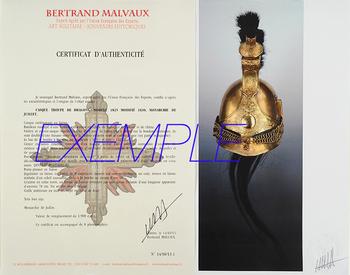
Next update Friday, december 12 at 13:30 PM
FOR ALL PURCHASES, PAYMENT IN MULTIPLE CHECKS POSSIBLE
bertrand.malvaux@wanadoo.fr 06 07 75 74 63
SHIPPING COSTS
Shipping costs are calculated only once per order for one or more items, all shipments are sent via registered mail, as this is the only way to have proof of dispatch and receipt.
For parcels whose value cannot be insured by the Post, shipments are entrusted to DHL or Fedex with real value insured, the service is of high quality but the cost is higher.
RETURN POLICY
Items can be returned within 8 days of receipt. They must be returned by registered mail at the sender's expense, in their original packaging, and in their original condition.
AUTHENTICITY
The selection of items offered on this site allows me to guarantee the authenticity of each piece described here, all items offered are guaranteed to be period and authentic, unless otherwise noted or restricted in the description.
An authenticity certificate of the item including the description published on the site, the period, the sale price, accompanied by one or more color photographs is automatically provided for any item priced over 130 euros. Below this price, each certificate is charged 5 euros.
Only items sold by me are subject to an authenticity certificate, I do not provide any expert reports for items sold by third parties (colleagues or collectors).
FOR ALL PURCHASES, PAYMENT IN MULTIPLE CHECKS POSSIBLE
bertrand.malvaux@wanadoo.fr 06 07 75 74 63
An authenticity certificate of the item including the description published on the site, the period, the sale price, accompanied by one or more color photographs is automatically provided for any item priced over 130 euros. Below this price, each certificate is charged 5 euros.
Only items sold by me are subject to an authenticity certificate, I do not provide any expert reports for items sold by third parties (colleagues or collectors).
